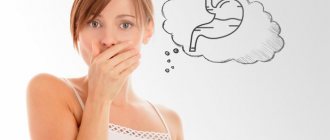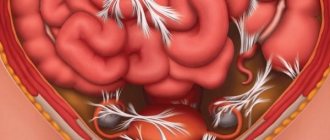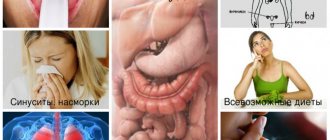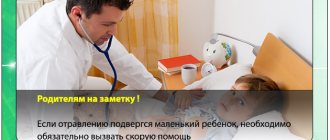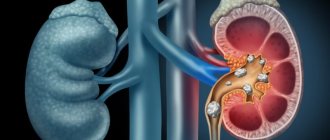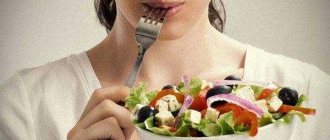Why does my stomach hurt along with my temperature?
Abdominal pain syndrome is not considered an independent pathological condition. Accompanied by various additional symptoms. Based on the general picture of clinical manifestations (nausea, diarrhea, constipation, headache and others), a conclusion is made about the final diagnosis.
When the syndrome is accompanied by fever, the presence of diseases can be assumed:
- Intestinal obstruction.
- Acute attack of appendicitis.
- Inflammatory process in the pancreas (pancreatitis).
- Exacerbation of chronic cholecystitis.
- Perforation of an ulcer of the stomach, duodenum, gall bladder with the contents entering the abdominal cavity.
- Various intestinal infections.
- Oncological changes in the tissues of the pelvis and gastrointestinal tract of a malignant nature.
- Poisoning from food or household chemicals.
- Salmonellosis.
- Dysentery.
- Cholera.
- Rotavirus infection.
Pain and fever may indicate acute inflammation of any organs of the abdominal cavity: kidneys, urinary tract, liver, genitals; they can be a sign of the development of complications due to hepatitis and intestinal infections.
This clinical picture is observed when the last (thermal) stage of abdominal cancer occurs.
What is the reason for a temperature of 38 in an adult and abdominal pain?
An increase in temperature to 38-39 degrees, accompanied by sharp contractions in the abdomen (namely in the navel area), is recorded in an adult in the following cases:
- inflammation of the appendix;
- peritonitis;
- cholecystitis;
- pancreatitis;
- malignant tumor neoplasm;
- duodenitis;
- infectious diseases (salmonellosis, staphylococcal infections, botulism, cholera, others);
- infestation of helminths;
- stomach ulcers;
- intestinal obstruction;
- problems with the ovaries in women.
If you experience severe and persistent pain in the abdominal area, you should seek medical help.
Infectious diseases
Fever and abdominal pain, accompanied by a general deterioration in condition, vomiting and nausea, are harbingers of illnesses caused by infection.
Common infectious diseases.
- Food poisoning.
- Gastroenteritis.
- Salmonellosis.
- Staphylococcal food toxicosis.
- Acute intestinal infections.
The diseases are common among people of any age category. However, the peak of infection activity is recorded in the hot season.
Food poisoning
Accompanied by disorders of the digestive system. Develops when consuming low-quality, contaminated or expired products. The provocateurs are harmful microorganisms. The main manifestations include dizziness, fever, chills, intestinal upset and flatulence.
Development of gastroenteritis
This happens due to the penetration of a virus or bacteria into the body. The main provocateurs are E. coli and rotavirus infection. Gastroenteritis is most often recorded in childhood. Accompanied by pain in the stomach and abdomen, elevated body temperature, aching bones, sweating, nausea and vomiting. Distinctive features of the disease are an increase in the frequency of vomiting and the presence of repeated loose stools.
Infectious salmonellosis
It is a complex infectious disease, the main provocateur of which is bacteria of the genus Salmonella. The disease is dangerous for both adults and children. Bacteria enter the body through the consumption of dirty vegetables, fruits and failure to comply with personal hygiene rules. Symptoms of the disease are pronounced, their manifestation is recorded within 6–48 hours after the penetration of the pathogenic microorganism into the digestive tract. The victim complains of severe pain in the abdomen and stomach, nausea, repeated vomiting, intestinal upset and high body temperature.
Staphylococcal food toxicosis
An acute disease that occurs when eating food containing toxic substances. Damage to the body occurs due to the sedimentation of toxins in the gastrointestinal tract. Typical manifestations of the disease are cramping pain in the abdomen and stomach, fever, general weakness, chills, aches in the muscles and the whole body.
Acute intestinal infections
If they are present, the stomach hurts greatly. The following pathogenic microorganisms can lead to the development of a burdened clinical picture: salmonella, vibrio, staphylococcus, campylobacter, rotavirus.
The penetration of infection into the body is indicated by elevated body temperature, sharp pain in the stomach and lower abdomen, watery bowel movements and repeated vomiting.
How to make the pain worse
Exacerbation of symptoms is often associated with incorrect actions of the patient himself. If you delay and do not call a doctor, hoping that everything will be restored by the body’s internal reserves, new symptoms will be added to the primary symptoms (for example, vomiting, diarrhea, bleeding).
When these signs appear, drug therapy is required. Such pathologies are dangerous for both adults and children.
Parents bear full responsibility for the life and health of their child. The procedure in both cases is the same: no independent treatment.
When making sudden movements against the background of an ulcer, pancreatitis, appendicitis, an intensification of the syndrome is observed.
Also, factors provoking these complications are considered:
- Consumption of alcoholic beverages.
- Smoking tobacco products.
- Ingestion of foods that are difficult to digest or irritate the mucous membrane (fatty meat, fried foods, hot sauces and spices).
Until a medical report on the diagnosis appears, a gentle diet and exercise regime is required. In some cases, the diet will be prescribed for the rest of your life.
How long does the torment last?
Inflammation of the gastric mucosa, which has passed into the chronic stage, may not manifest itself for a long time. More precisely, the symptoms are weak, the patient can even ignore the problem. But then exacerbations occur. This is an inevitable phenomenon. It lasts differently: from several minutes to several days. Everything is connected with the general condition of the patient, the degree of damage to the organ, the type of illness, and the reasons for its occurrence.
The danger of exacerbations is that their manifestations can be similar to many other problems with the digestive system. Moreover, an insidious illness can either subside, lulling vigilance, or arise with renewed vigor.
To understand the full picture of what is happening during the first exacerbation, you must immediately go to the clinic and be examined according to all the rules. If the symptoms have subsided, this does not mean that everything has fallen into place and nothing else will bother you. Here are the tests you should undergo:
- Biochemical and general blood tests, as well as general urinalysis.
- Examination of the digestive organ from the inside using a probe with a camera (fibrogastroduodenoscopy).
- Analysis of stool for the presence of blood.
- Study on the acidity of gastric juice (RN-metry).
- Tests for the detection of Helicobacter pylori.
The doctor will see both the problem itself and the extent of damage to the mucous membrane. Perhaps a completely different illness will be discovered. Sometimes the stomach hurts for other reasons. In this case, the treatment will correspond to the diagnosis.
What does dull, pulling, point or cutting pain in the abdomen indicate?
The presence of pain in any part of the body indicates the progression of the disease. The nature of the pain syndrome is classified into pathological and physiological (the case of pregnancy).
Nagging painful sensations can be a temporary ailment or appear suddenly with such intensity that the patient cannot cope with them (there may be a serious threat to health).
Painful sensations indicate:
- gastrointestinal disorders;
- kidney problems (pain radiates to the lumbar region);
- inflammation of the urinary and reproductive systems.
Any disorder of the gastrointestinal tract is a consequence of ongoing diseases; their carrier often has no idea about the presence of problems in the body.
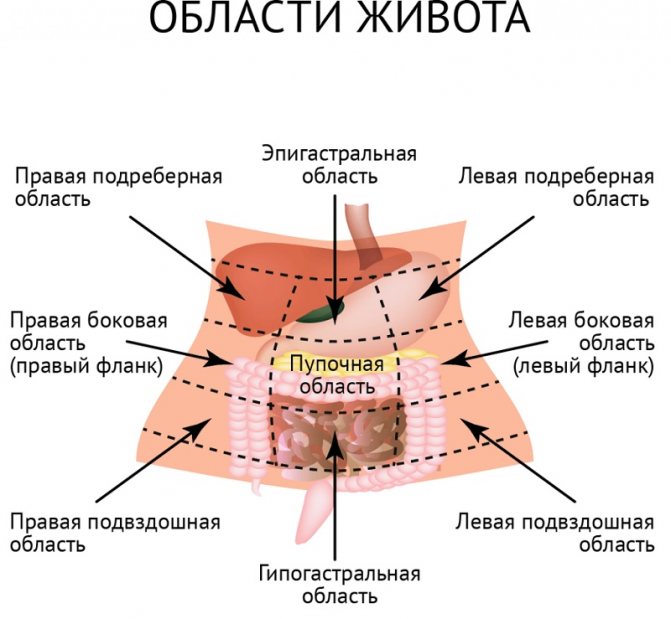
Reasons why the normal functioning of the gastrointestinal tract is disrupted:
- Peptic ulcer: the intensity of pain varies - from moderately weak to unbearably strong. In case of acute cutting pain, urgent medical intervention is carried out, because probably the release of acidic stomach contents into the abdominal cavity.
- Inflammation of the mucous membrane (gastritis): manifests itself in dull, aching pain, heartburn (often after a person has eaten).
- Pancreatitis: pain begins in the upper abdomen, tormenting for several days, while eating, the discomfort intensifies (bloating is felt, the temperature may rise).
- Inflammation of the gallbladder: pain in the right hypochondrium, often radiating to the arm, chest and neck on the right side.
Diseases reveal themselves by tingling, nausea, vomiting, and fever.
Rare sources:
- Stomach polyps: diagnosis is difficult; the medical history consists of a dull aching pain on palpation, bleeding, nausea, and vomiting.
- Cancer: characterized by a constant, mild aching feeling in the stomach.
- Stress: great physical and emotional stress can cause disturbances in the functioning of the gastrointestinal tract, causing a feeling of pain in it (stool upset and vomiting may occur).
- Allergy: when an allergen enters the body, an aching feeling appears that does not have a clear localization.
If the pain is physiological in nature, i.e. a woman is carrying a child, this is a natural phenomenon: the growing uterus puts pressure on nearby organs, resulting in a feeling of discomfort.
Appendicitis
Appendicitis is a purulent inflammation of the appendage of the cecum. Signs of the disease include diarrhea, sometimes constipation, increased gas formation, high body temperature, nausea, ending with vomiting.
When palpating the lower abdomen - its right quadrant - a person feels a pain syndrome, the strength of which varies: it all depends on the severity of the condition
In the acute form of appendicitis, the clinical picture of the disease appears sharply and gradually intensifies. If the pain does not disappear for more than 6 hours, then the person needs urgent hospitalization.
Pain with appendicitis has characteristic symptoms. Initially, they have a pulling character with a localization zone in the umbilical region. As the condition worsens, the pain spreads to the right lower abdomen, becomes bursting and becomes permanent.
A typical sign of inflammation of the appendix is increased pain when the patient lies on his left side. The most common treatment for appendicitis is surgical removal of the inflamed caecum, but in some cases drug therapy is practiced.
When do you need to see a doctor urgently, and which doctor will help?
Of course, going to the clinic at the first sensation of pain is not necessary. Perhaps a hearty breakfast is poorly absorbed by the body, or the yogurt has expired.
But there are a number of cases when seeing the doctor on time means avoiding negative consequences:
- A strong, piercing pain that appeared for the first time.
- For a long time (up to a week) the feeling of discomfort and heaviness does not go away; if the feeling intensifies, then it is better not to wait a week, but to consult in time.
- Flatulence lasting a couple of days.
- Associated symptoms include frequent urination or a burning sensation that appears during the process.
- Stool disorder is observed for four or more days.
- An elevated temperature is added, which indicates an inflammatory process in the body.
- Pain radiating to the chest, neck, lower back.
If a woman is in an “interesting” position, then any deviation from the norm is a reason for urgent consultation with a specialist.
There are a number of accompanying symptoms that indicate that you cannot do without medical help:
- changes in the patient’s behavior: previously cheerful and full of energy, with the onset of the disease he becomes apathetic and lethargic;
- vomit;
- problems with stool;
- the abdominal wall is in a tense state;
- the pulse is quickened, the person feels hot and cold, and perspiration appears;
- pronounced pallor of the skin.
Doctors of different specializations help with existing problems. A gastroenterologist will help if we are talking about gastrointestinal disorders (usually related to food). If you suspect genitourinary problems, you should seek help from a urologist; women should visit a gynecologist. If discomfort is caused by the groin area, a proctologist will help.
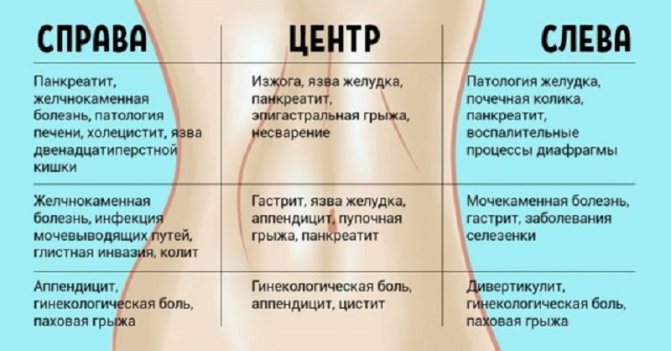
If it is difficult for the patient to self-diagnose the condition (“It just hurts here, but I don’t know what”), it is best to start visiting the clinic with a therapist, who will prescribe the appropriate tests and tell you which specialist to contact. If a child needs help, a pediatrician will consult.
Dangerous moments
Exacerbation of gastritis, the symptoms of this condition can be very dangerous in the case of severe pathology of the digestive organ with aggravating consequences. Ulcers, atrophy, bleeding, malignant degeneration of the disease - this is what requires immediate hospitalization. With gastritis of a dangerous form, a person feels:
- The pain lasts longer and is stronger than usual.
- There is bloody discharge in the vomit, and the stool becomes black due to blood entering the intestines.
- The feeling of weakness intensifies, the person feels feverish.
You must immediately call an ambulance before an even more dangerous condition occurs. Before the ambulance arrives, you can take anything only after coordinating all actions with your doctor. Even a dangerous aggravated illness has a chance to be converted into a calm form. Before doctors arrive, they usually advise you to lie on your side with your knees bent. Painkillers - only on the recommendation of a doctor.
Top medications to reduce abdominal pain, painkillers
The course of treatment is selected by the doctor. But if it is not possible to visit a doctor, and it becomes unbearable to endure, the use of painkillers is allowed.
No-shpa
Dispensing in pharmacies is made without a doctor's prescription. The main active ingredient is drotaverine, which has an antispasmodic effect.
Indications for use: spasms associated with disruption of the gastrointestinal tract, with disorders of the digestive system.
Use with caution in children and pregnant women.
An antispasmodic can significantly reduce blood pressure, therefore, people with hypotension are advised to monitor their condition when taking No-shpa. Taking the drug for more than two days without a doctor's prescription is not recommended.
Metoclopramide
The drug is not available in pharmacies without a doctor's prescription. The main active ingredient is metoclopramide, it stops vomiting, normalizes the gastrointestinal tract, and eliminates pain.
The drug is strictly contraindicated for pregnant women and children. Also not allowed for use by women during lactation.
The use of the drug together with alcohol is unacceptable. It is recommended to stop driving a car for the next 24 hours after taking Metoclopramide.
Maalox
The drug is available in the form of chewable tablets and suspension. Can be purchased at any pharmacy without a prescription. The drug is based on algeldrate and magnesium hydroxide, which have an enveloping effect and cope with pain in the upper abdomen. Actively fights heartburn, a feeling of heaviness and bloating.
Not recommended for use by pregnant and nursing mothers, children under 15 years of age, persons with diabetes mellitus, or kidney disease.
It is permissible to take no more than 12 tablets per day.
Duspatalin
The release form of the drug is tablets. Can be purchased in pharmacies without a prescription. Mebeverine is the main active ingredient, which has an antispasmodic effect, fights colic and heaviness.
Not recommended for women expecting to give birth.
Motilium
Lozenges. Available without a prescription. The drug is based on the substance domperidone, which has a reducing effect on the walls of the stomach. Eliminates nausea, vomiting, and discomfort in the epigastric area. Effective against overeating.
There are contraindications for persons under 10 years of age and pregnant women.
Folk wisdom to help
To ensure that the treatment of exacerbation of gastritis does not last long and is as successful as possible, you can and should use traditional methods of combating inflammation of the digestive system. Gastritis, which usually worsens in autumn and winter, will be met fully armed if you resort to the following methods:
- Mix honey with oil in equal proportions and take a tablespoon half an hour before meals. This method allows you to increase the production of hydrochloric acid if there is not enough of it for digestion. This treatment should continue for at least four weeks.
- Having burdock root, you can pour it with boiling water in a cup at the rate of a teaspoon of chopped root vegetable per 200 grams of water. Let it sit overnight, and in the morning you need to drink the entire portion at once 30 minutes before your meal.
- Cabbage juice from fresh leaves helps stimulate the function of the digestive organ. It benefits those who have little acid. How long to take this remedy must be agreed with your doctor. Usually - no less than a month.
Knowing all the manifestations of exacerbation of gastritis, symptoms and treatment of the disease, you can be confident in your actions to take adequate measures. And together with the doctor, put the aggravated “enemy” in its place.
Preventive measures to avoid abdominal pain
There are a number of measures aimed at preventing gastrointestinal diseases:
- avoid evening snacks and overeating before bed;
- Strictly limit or eliminate the consumption of foods high in fat, flour, and sweets;
- coffee is an enemy to health, try to give it up completely;
- food products made with the help of deep processing of meat (sausages, sausages) are one of the possible causes of the development of colon cancer: by refusing to eat them, you will not lose anything; eating natural meat is more beneficial;
- after eating, avoid any stress on the abdominal area for two hours;
- The most banal, but most useful advice of all - do not forget to wash your hands after visiting the toilet and before eating.
Although these recommendations seem primitive, their effectiveness has long been proven. It is not difficult to follow them, and the effect will be obvious.
A little different
With exacerbation of gastritis with low acidity, the symptoms are slightly different. With gastritis of this type the following is observed:
- Bad breath. Belching with a “rotten egg” effect.
- A feeling of fullness in the digestive organ, dull and aching pain in this area.
- Increased gas formation, intestinal pain worsens for this reason.
- The stool is disrupted if gastritis has worsened, because food is not digested as it should. Either loose stools or constipation.
- Feeling sleepy after eating, increased sweating and fatigue.
How long an exacerbation of gastritis lasts depends on various factors. From previous compliance with the doctor’s recommendations, neglect of the disease, age and condition of the body as a whole, adequate care. Drugs for treatment are selected individually. You must drink them strictly according to the prescription. This is very important, otherwise no medications will help if you take them at your own discretion, changing the dose yourself.
What causes sudden abdominal pain?
Pain is explained by the body's response to irritants. By its nature one can determine the original source.
cutting
If the abdominal cavity seems to be cut into pieces, most likely the problem lies in the upper parts of the gastrointestinal tract: the stomach, duodenum, pancreas.
The appearance of pain: hydrochloric acid, which is part of the gastric juice, has an aggressive effect on the mucous membrane, which is already damaged.
This is where pain of a burning nature arises. If a person is sick with pancreatitis, then damage to the solar plexus becomes quite possible.
Intestinal colic also reveals itself as a cutting pain. They appear against the background of stress, overwork and other reasons. If a person has acute gastritis, to which food poisoning is added, then such symptoms cannot be avoided.
Stabbing
For various intestinal problems, the most common complaint among patients is stabbing pain in the navel area. Various damaging factors affect the smooth muscles of the intestinal wall, thereby causing its sharp contraction.

Intestinal spasms can simultaneously manifest as stabbing and cutting pain, especially when it comes to food poisoning.
Shingles in the abdominal area
Dull pain surrounding the abdominal cavity has not many causes. It all depends on its location. If it appears on both sides and extends to the top of the navel, then it may be inflammation of the pancreas, or acute pancreatitis. One of the factors in the manifestation and progression of diseases is considered to be excessive consumption of alcoholic beverages.
If the symptom appears on one side along the lower rib, then we can talk about damage to the spinal nerve. The lesion may be a consequence of a previous injury or intervertebral hernia.
Paroxysmal
If a painful feeling manifests itself in attacks according to the “let go-grabbed” principle, then most likely the problem is an intestinal disorder. The process is explained by intestinal peristalsis (complex movements that move a bolus of food).
Pulsating
Perhaps the most dangerous species. It may indicate a purulent process in the abdominal cavity. For example, it could be an abscess that appears as a result of acute appendicitis.
An inflamed pancreas manifests itself with the same symptoms.
Competent actions
Exacerbation of gastritis, treatment during the period of its peak expression should be carried out under medical supervision. How to treat and what to treat during exacerbation of gastritis, let the doctor decide. Medicines, in addition to traditional medicine and diet, will help not only relieve the acute phase, but also prevent a recurrence of the crisis. Alas, it is most likely impossible to cure a chronic disease completely, but it is possible to relieve the acute manifestations of the disease, and this must be done on time!
Here are the measures you should take to avoid aggressive exacerbation of gastritis:
- Do not drink alcohol (in any form), quit smoking.
- To prevent the condition from worsening, forget about late evening meals.
- Do not take different medications, prescribe doses and types of medications yourself.
- Eat in moderation, without overfilling the digestive organ.
- Not only the aggravated disease, but also a healthy stomach does not like fried and fatty foods, as well as too spicy seasonings. It is worth remembering this always.
- There is no need to worry and suffer over trifles. Especially during meals. You should eat with pleasure and slowly, chewing your food thoroughly!
If there is too little hydrochloric acid, then you need to eat at certain hours, strictly on time, then the stomach will adapt to intensify its work precisely during these periods of time.
Important! Self-medication for acute gastritis is dangerous. Even if you use traditional medicine, you need to coordinate this with your doctor. Since some herbal preparations are incompatible with medications. In addition, the correct dosage of folk remedies is not only a guarantee of the expected help, but also protection from the undesirable consequences of thoughtless use of vegetable oils and extracts.
What do various abdominal pains indicate when eating various foods?
According to medical statistics, a third of the world's population experiences discomfort in the abdominal area due to poor nutrition. Therefore, for those who have digestive problems, it is better to avoid some names.
Legumes
Belonging to the legume family, vegetables are rich in minerals and vitamins. But at the same time, the oligosaccharides they contain increase gas formation produced by the digestive system. This is where pain occurs, irritable bowel syndrome.
Soaking legumes overnight will improve their properties. But if this procedure is futile, it is better to switch to whole grains.
Carbonated drinks
If in the case of legume products, complete rejection of them is recommended only under extreme circumstances, then rejection of carbonated drinks is one of the prerequisites for a healthy stomach and intestines.
Any “soda” is characterized by a high level of carbon dioxide, which contributes to bloating and the appearance of pain. That is, with every sip of a carbonated drink a person consciously adds gases to the body, which is where the spasms begin.
Since “soda” does not have the slightest nutritional value, you can safely replace it with freshly squeezed juices and fresh juices.
Wheat
According to studies, gluten contained in wheat can contribute to digestive system disorders. But the usual diet of many people largely consists of this cereal.
If you are hypersensitive to gluten, it is recommended to completely avoid this crop, as well as similar ones that also contain gluten: rye, barley, oats, etc.
Eating products containing wheat grains can lead to pain, diarrhea, flatulence, and bloating.
Onion
Most people, even with their mother’s milk, learn the rule that onions are healthy, the more you eat, the better, you will get sick less.
But, if a person has problems with the gastrointestinal tract, then the sulfur compounds and fructans that make up raw onions will cause flatulence, bloating and pain. To avoid this, it is recommended to replace onions with other spicy herbs that do not have a similar effect.
Dairy
Due to the high level of lactose, contrary to the general opinion about their usefulness, they cause irreparable harm to health. Butter, cheeses, milk, and yogurt contain milk sugar, which causes discomfort in the stomach.
People who are lactose intolerant suffer from bloating, intestinal cramps, diarrhea and increased gas formation after consuming milk-containing products.
An excellent alternative to cow's milk is soy, rice, coconut or almond milk. They are also rich in beneficial microelements, but do not cause problems with the gastrointestinal tract.
Apples
“An apple a day and you don’t have to go to the doctor,” says a well-known proverb. But the high fructose and fiber content makes the apple a source of bloating, excess gas accumulation in the intestines and digestive problems.
If it is not possible to completely give up apples, you should try cooking them - this will reduce the pain of side effects.
Garlic
The fructans and sulfur contained in garlic cloves contribute to the appearance of bloating, cramps, and stomach pain. Garlic is also considered a powerful allergen. People with garlic intolerance experience painful flatulence and unpleasant belching after eating it.
Heat treatment of garlic usually helps to avoid unpleasant consequences after eating.
Don't rush to completely give up your favorite foods. Try reducing the amount of them in your diet and subjecting them to various treatments, which will reduce the likelihood of side effects.
Treatment of flatulence
How to treat bloating? First, it is necessary to establish the cause causing excessive gas formation, and if this is caused by a disease, then treatment should be directed specifically at it. That is why, drugs for bloating can only eliminate that unpleasant and awkward feeling when gas is released, but they cannot cure a possible illness. However, we will also consider anti-bloating remedies.
Important! Drugs for the treatment of bloating are selected strictly individually by a specialist.
Medicines that are most often prescribed for flatulence:
Defoamers. Drugs that destroy fine-bubble foam containing gas, reduce its volume and reduce pressure on the intestinal walls - “Espumizan”, “Colikid”, “Babycalm”.
Adsorbents. Adsorb gases, toxins and pathological microorganisms on their surface - “Activated carbon”, “Enterosgel”, “Smecta”.
Prokinetics. Promote increased intestinal motility and removal of gases - “Motilium”, “Cerucal”, “Paszhiks”.
Antispasmodics. By relaxing the smooth muscles of the intestinal wall, they reduce pain caused by flatulence and eliminate spasms - “No-shpa”, “Papaverine”, “Drotaverine”.
Enzyme preparations. These drugs contain pancreatic enzymes and auxiliary components. They promote the breakdown of fats, plant fiber and the absorption of nutrients - “Festal”, “Pancreatin”, “Mezim”.
People who are constantly susceptible to flatulence need to adhere to some dietary rules - exclude from their diet (or at least reduce consumption) foods that cause gas formation and bloating:
- bread (black and baked goods);
- fruits (orange, grapefruit, lemon, banana, raisins, prunes);
- vegetables (cabbage, tomatoes, peas and other legumes);
- carbonated drinks;
- sugar;
- breakfast cereals;
- fast food;
- spicy and fatty foods;
- alcohol.
It is also recommended to consume fermented milk products, and consume vegetables not raw, but boiled or steamed.
Dill. Pour 1 tbsp into a thermos or teapot. spoon of dill seeds, pour 1 glass and leave for an hour. Strain and drink 1 glass per day. If you give it to a child, then 1 teaspoon 3 times a day. Store in a cool place in a glass container and warm to room temperature before use.
Dill, fennel and cumin. Pour 2 teaspoons of mixed seeds into a glass of boiling water and leave for 2 hours. Take a quarter glass every hour.
Chamomile. Brew 2 teaspoons of chamomile with a glass of boiling water and leave for 3 hours. Take 1/3 cup 4 times a day.
Mint. Brew 2 teaspoons of crushed leaves with a glass of boiling water. Drink in small portions throughout the day.
Ginger. Dissolve a quarter teaspoon of ginger after meals.
Garlic. Take finely chopped, dried and ground garlic on the tip of a knife 2 times a day after meals. Store in a glass jar, tightly closed, in a cool, dark place.
Potato juice. In the morning, on an empty stomach (1 hour before meals), drink a glass of freshly squeezed potato juice. After drinking the juice, go back to bed for half an hour. Repeat for 10 days. Potato juice can make you sick, so you can take mint drops after the juice.
Anise. 1 tbsp. Pour boiling water over a spoonful of anise seeds and let stand for 3 hours in a thermos. Take a quarter of a glass 5 times a day 30 minutes before meals.
Dandelion. Pour 2 teaspoons of dandelion roots with cold boiled water. Leave for 8 hours. Take a quarter of a glass before meals.
Nuts, lemon and clay. Take 100 grams of walnuts and pine nuts, chop together with 1 unpeeled lemon. Add 30 g of purified clay to the mixture, mix and store in the refrigerator. Take 2 times a day before meals.
Flatulence, like any ailment, is better to prevent than to treat, therefore, following simple rules will avoid bloating:
— eat right (don’t overeat, don’t eat incompatible foods); - do not talk while eating, take your time and chew your food thoroughly; - drink at least 2 liters of water per day; — move (do exercises in the morning, walk in the fresh air).
These simple tips will help you avoid excessive gas and awkward moments.

